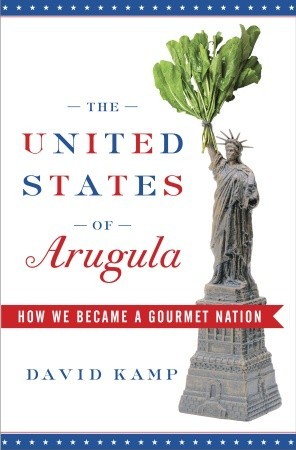The United States of Arugula: How We Became a Gourmet Nation, by David Kamp
Sep 25
2006

David Kamp’s The United States of Arugula: How We Became a Gourmet Nation is a sprawling, gossipy account of some of America’s most influential post-World War II culinary icons. It doesn’t fully deliver the explanation promised by its subtitle (although I doubt that any single book could), but it works beautifully as a human-interest story, dipping into the careers of everyone from Alice Waters to Emeril Lagasse.
Kamp’s book can be roughly divided into three sections. The first focuses on the “Big Three”: Julia Child, James Beard, and Craig Claiborne; the second moves on to the socially aware, fresh food-obsessed, ex-hippie types that opened places like Berkeley’s Chez Panisse; the third is devoted to the food celebrities of the last twenty-five years—people that came of age in a world that was beginning to regard American cuisine as a force to be reckoned with. Kamp is a writer for Vanity Fair, and The United States of Arugula displays his skill as a sensationalist biographer. The book works very well—sometimes a little too well—when the author sets out to humanize his larger-than-life subjects. (I’m praying to forget some of the stomach-turning tidbits that he included about Craig Claiborne’s childhood as soon as possible.)
Unfortunately, the book might have improved in the hands of a more aggressive editor. Kamp will share one perfect, illuminating anecdote (attempting to give a sense of how self-important the people at Chez Panisse were, he points out that they were releasing commemorative posters for the restaurant’s second birthday), and then follow it up with four others illustrating the same thing. I’m as fond of a salty story as the next book reviewer, but there are so many here that I found it difficult to even keep the names straight.
Although Kamp seems more interested in the people doing the cooking, The United States of Arugula does feature some impressive descriptions of food. Still, none of the creations that Kamp mentions made me feel hungry or inspired me to attempt to re-create them at home. I think that’s a testament to the artistry of the chefs featured in the book; reading a description of a famous painting might inspire a wish to see it, but you’re unlikely to pick up a paintbrush and try to one-up the artist. (Jackson Pollack aside, obviously.) It’s equally hard to imagine re-creating something like Barry Wine’s “beggar’s purses”. Kamp describes them on page 301—miniature crepes stuffed with beluga eggs and crème fraîche, knotted shut with chive strings.
Sure, the beluga eggs and crème fraîche are a possibility, but chive strings? Not a chance.
Kamp’s book can be roughly divided into three sections. The first focuses on the “Big Three”: Julia Child, James Beard, and Craig Claiborne; the second moves on to the socially aware, fresh food-obsessed, ex-hippie types that opened places like Berkeley’s Chez Panisse; the third is devoted to the food celebrities of the last twenty-five years—people that came of age in a world that was beginning to regard American cuisine as a force to be reckoned with. Kamp is a writer for Vanity Fair, and The United States of Arugula displays his skill as a sensationalist biographer. The book works very well—sometimes a little too well—when the author sets out to humanize his larger-than-life subjects. (I’m praying to forget some of the stomach-turning tidbits that he included about Craig Claiborne’s childhood as soon as possible.)
Unfortunately, the book might have improved in the hands of a more aggressive editor. Kamp will share one perfect, illuminating anecdote (attempting to give a sense of how self-important the people at Chez Panisse were, he points out that they were releasing commemorative posters for the restaurant’s second birthday), and then follow it up with four others illustrating the same thing. I’m as fond of a salty story as the next book reviewer, but there are so many here that I found it difficult to even keep the names straight.
Although Kamp seems more interested in the people doing the cooking, The United States of Arugula does feature some impressive descriptions of food. Still, none of the creations that Kamp mentions made me feel hungry or inspired me to attempt to re-create them at home. I think that’s a testament to the artistry of the chefs featured in the book; reading a description of a famous painting might inspire a wish to see it, but you’re unlikely to pick up a paintbrush and try to one-up the artist. (Jackson Pollack aside, obviously.) It’s equally hard to imagine re-creating something like Barry Wine’s “beggar’s purses”. Kamp describes them on page 301—miniature crepes stuffed with beluga eggs and crème fraîche, knotted shut with chive strings.
Sure, the beluga eggs and crème fraîche are a possibility, but chive strings? Not a chance.
Posted by: Julia, Last edit by: Julianka
No new comments are allowed on this post.
Comments
hecate
But... what WERE the stomach-churning details about Craig Claiborne? Inquiring minds want to know!
\r\n
\r\nLooks like a fun book. I have some birthday giftcards burning a hole in my pocket, so maybe I'll pick up a copy.